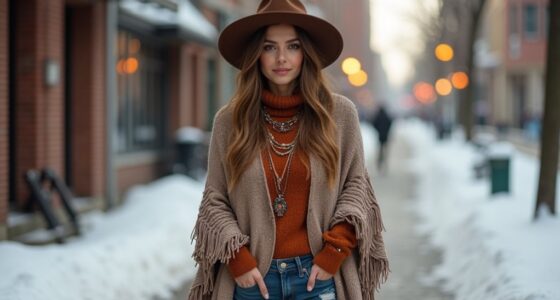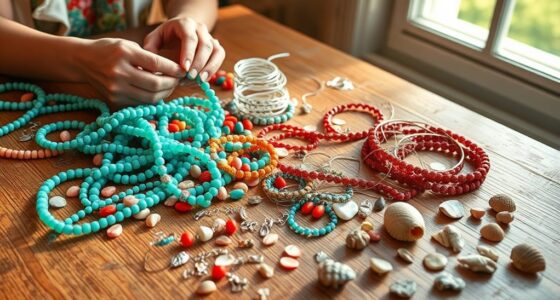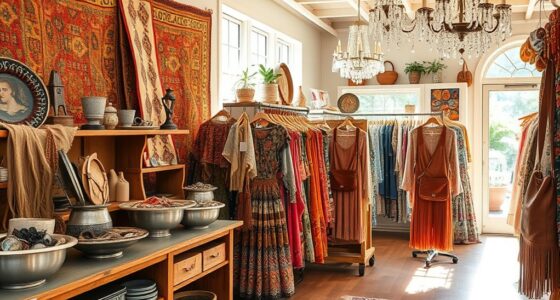To create boho-chic pieces from old garments, start by selecting thrifted fabrics with interesting textures, colors, or patterns. Deconstruct these clothes carefully, then redesign into relaxed silhouettes like tunics or maxi skirts, adding details like embroidery, fringe, or patchwork. Experiment with dyeing techniques and layered textures to enhance the organic vibe. Finish with accessories and styling tips to achieve a free-spirited look. Keep exploring to discover more ways to transform your wardrobe sustainably and creatively.
Key Takeaways
- Select thrifted or vintage garments with interesting textures, patterns, or embroidery for easy upcycling into boho-chic styles.
- Experiment with asymmetrical hemlines, layered fabrics, and draped silhouettes to create relaxed boho shapes.
- Embellish garments with embroidery, beading, appliqué, and natural elements like shells or feathers for personalized details.
- Use natural dyes, tie-dye, or patchwork techniques to add vibrant, earthy colors and textured patterns.
- Style your upcycled pieces with layered accessories, jewelry, and hats to achieve an effortless boho look.
Selecting the Perfect Garments for Upcycling
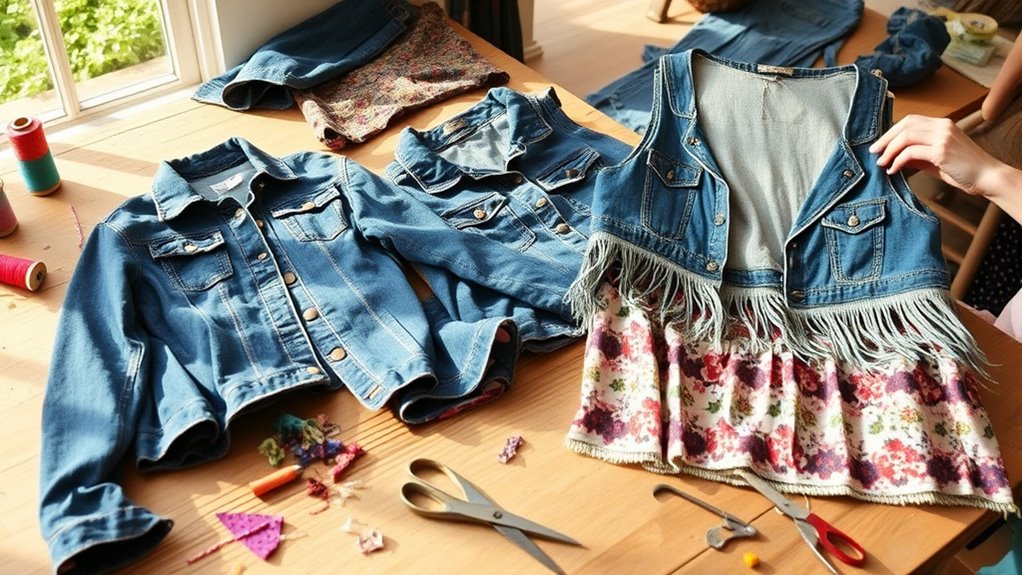
When choosing garments for upcycling, focus on thrifted or vintage pieces that have interesting textures, patterns, or embroidery, as these details can be enhanced or repurposed to create unique boho styles. Look for lightweight fabrics like cotton, linen, and rayon that drape well and contribute to the relaxed, free-spirited vibe of boho fashion. Opt for versatile shapes such as tunics, maxi skirts, or oversized shirts, which are easy to transform into layered or flowy pieces. Check for sturdy seams and minimal wear to ensure durability for long-term wear. Additionally, consider an earthy, pastel, or vibrant print palette to help you achieve authentic boho looks through upcycled clothes. Incorporating natural materials can further elevate the organic aesthetic of your DIY boho wardrobe. When planning your upcycling projects, exploring sustainable fashion practices can help you make environmentally friendly choices and reduce waste. Developing an awareness of mindfulness techniques can also enhance your creative process by helping you stay focused and present during your DIY projects. Practicing attention to detail during the crafting process ensures high-quality results and a polished finished piece. Being aware of breast cancer symptoms can also be beneficial for personal health awareness, especially when trying on garments or working in environments where long hours of wear or certain fabrics might affect skin health. Picking the right garments sets a strong foundation for your DIY boho wardrobe.
Simple Techniques for Deconstructing Old Clothes
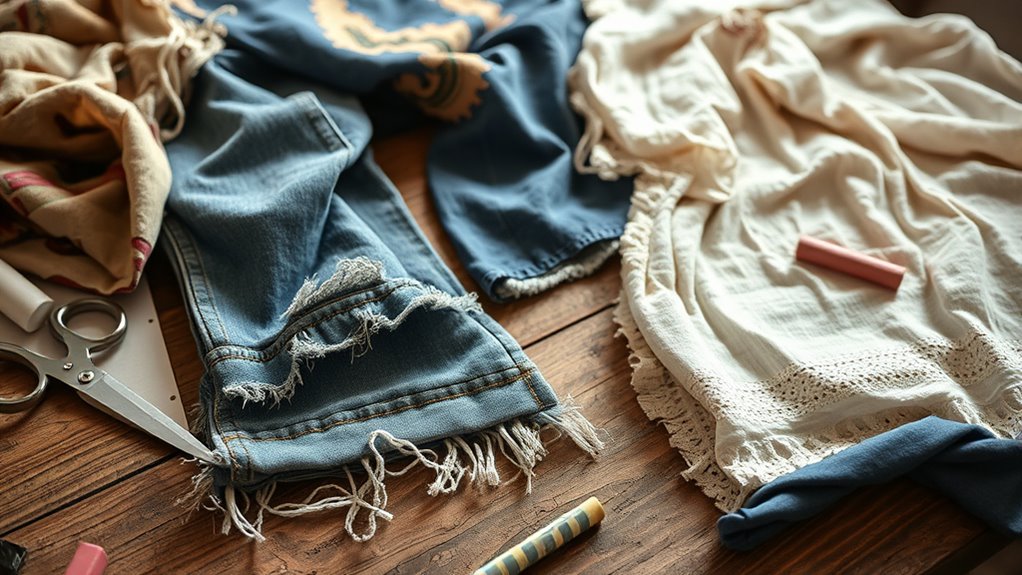
Deconstructing old clothes for upcycling requires careful handling to preserve the fabric and details that make your boho pieces unique. Start by gently removing seams with a seam ripper or scissors, taking care not to damage the fabric. Practice seam removal without patterns by focusing on freehand cutting and seam extraction, which helps maximize fabric usage. Keep interesting details like hems, sleeves, or embellishments intact—they can be perfect for future embellishments or integrating into new designs. Use fabric from multiple garments by cutting and rearranging pieces to create patchwork or layered looks. Remember, gentle and precise seam removal prevents tearing or fraying, ensuring your fabric remains in good condition for versatile projects. Patience and care are key to successful deconstruction. Additionally, understanding fabric preservation techniques can further enhance the longevity and appearance of your upcycled clothing, and interior design principles can even inspire creative ways to display or organize your garments. Being mindful of glycolic acid benefits can help you care for your upcycled garments, especially when considering fabric treatments or skincare routines to maintain the integrity of your creations. Incorporating upcycling techniques can also promote sustainable fashion practices and reduce waste.
Designing Unique Boho Shapes and Silhouettes
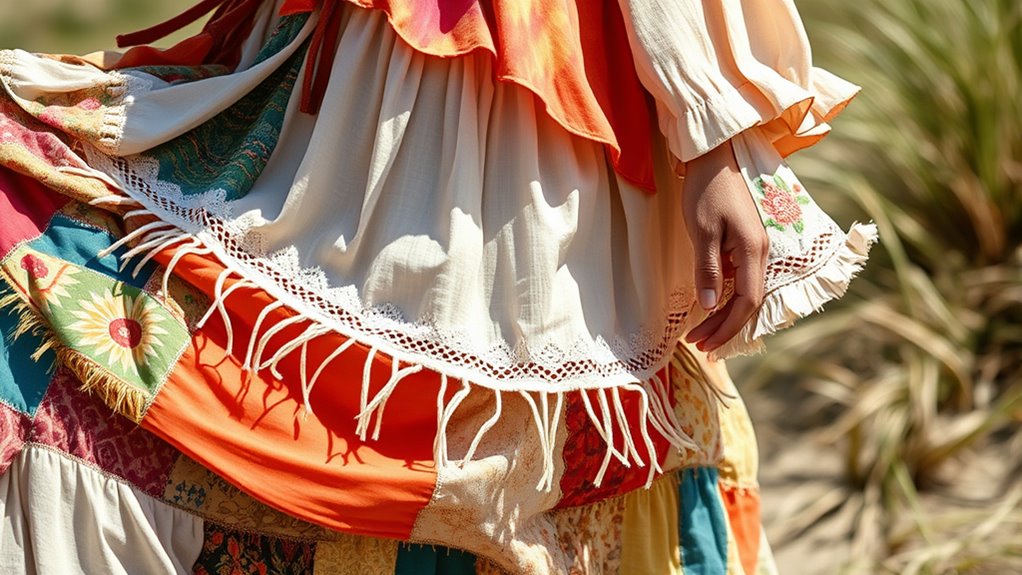
Have you ever wondered how to create fluid, eye-catching shapes that embody the free-spirited essence of boho style? To achieve this, experiment with asymmetrical hemlines, layered fabrics, and draped silhouettes to add movement and visual interest. Oversized, loose-fitting garments like tunics, kimonos, and harem pants help you capture the relaxed boho aesthetic. Incorporate gathered, ruched, or elasticized waistlines to add shape without sacrificing comfort. Mix patchwork, embroidery, and fringe details to enhance your piece’s uniqueness and silhouette. Focus on natural, flowing fabrics like cotton, linen, and rayon to achieve that soft, organic drape characteristic of boho clothing. These design techniques help you craft distinctive, free-spirited boho shapes that stand out beautifully. Additionally, understanding cybersecurity vulnerabilities can help protect your digital designs and personal data from online threats. Staying informed about precious metals market trends can also inspire unique design elements inspired by metallic textures and hues. Being aware of nail styles names can further inspire creative details and embellishments for your boho accessories or themed clothing accents.
Adding Embellishments With Textile Art and Accessories
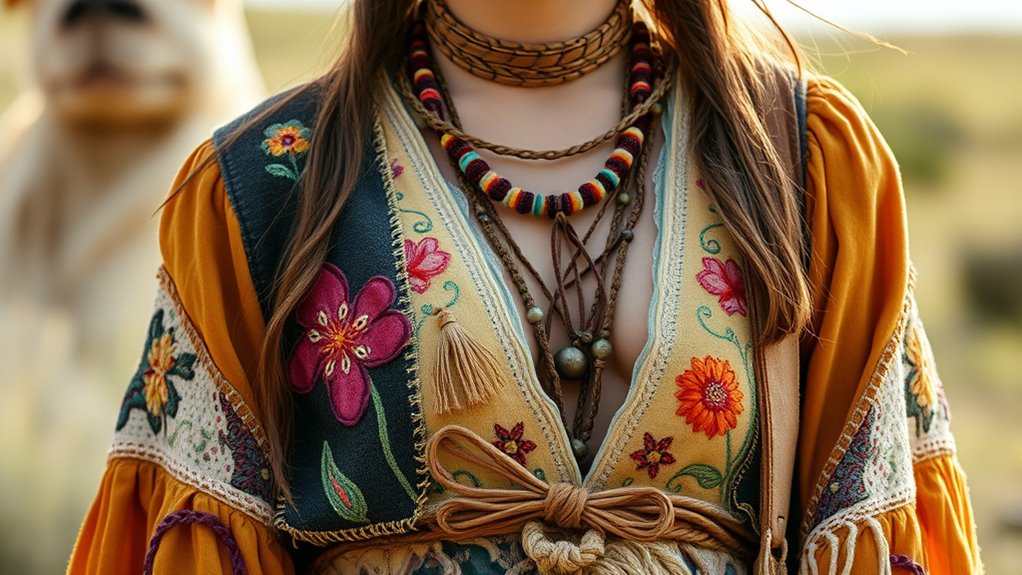
Adding textile art and accessories is a great way to personalize your boho clothing. By using techniques like embroidery, beading, or appliqué, you can create unique details that reflect your style. Incorporating natural elements or DIY fabric accessories further enhances the organic, eclectic vibe of your outfits. To ensure your embellishments stay secure and maintain compliance with clothing standards, consider learning about risk management strategies applicable to craft projects. Developing local knowledge of materials can help you choose the best supplies for your designs. Embracing the importance of foster positive relationships, much like the bonds celebrated in father-daughter connections, can inspire you to approach your crafting with patience and care.
Embellishment Techniques Overview
Embellishing boho clothing with textile art techniques and accessories allows you to create unique, textured pieces that reflect your personal style. Embellishment methods like embroidery, appliqué, and patchwork add depth and visual interest, while layered textiles such as lace overlays or sewn-on patches enhance the eclectic vibe. You can incorporate natural elements like beads, shells, feathers, and fringe to emphasize the earthy, free-spirited aesthetic. Hand-stitching and fabric painting let you personalize designs with intricate or bold patterns. Adjustable settings like needle tension and stitch length can help achieve precise and professional-looking embellishments. Accessories like brooches, pins, and charms make it easy to customize your garments, adding versatility and flair. Understanding color accuracy is essential to ensure that your embellishments complement the overall look and true hues of your fabric choices. Combining these techniques results in one-of-a-kind boho pieces that showcase your creativity and upcycled garments beautifully.
Accessorizing With Textile Art
In boho fashion, textile art accessories instantly elevate simple garments by infusing them with personalized, handcrafted details. Embellishing with techniques like embroidery, patchwork, and fabric appliqué adds unique, artisanal touches that enhance the bohemian vibe. Incorporate natural materials such as shells, beads, feathers, and fringe into your textile art accessories for earthy, textured accents that perfectly complement your outfit. Hand-stitched embroidery or freeform quilting allow for spontaneous, one-of-a-kind embellishments that showcase your craftsmanship and individual style. Adding woven belts, tasseled scarves, or fabric flower crowns can transform basic pieces into statement boho accessories. By combining various textile art elements, you create layered, multidimensional accents that not only elevate your look but also reflect your creative spirit. Engaging in self-awareness through textile art can help you connect more deeply with your personal style and intentions, making your accessories even more meaningful. Exploring the symbolism behind different textile motifs can further deepen your connection to your craft and its spiritual significance. Additionally, experimenting with techniques like fabric dyeing and distressing can add authentic, vintage-inspired touches to your creations. Incorporating textile art principles such as texture and color harmony can help unify your accessories for a cohesive aesthetic.
Experimenting With Dyeing and Color Techniques
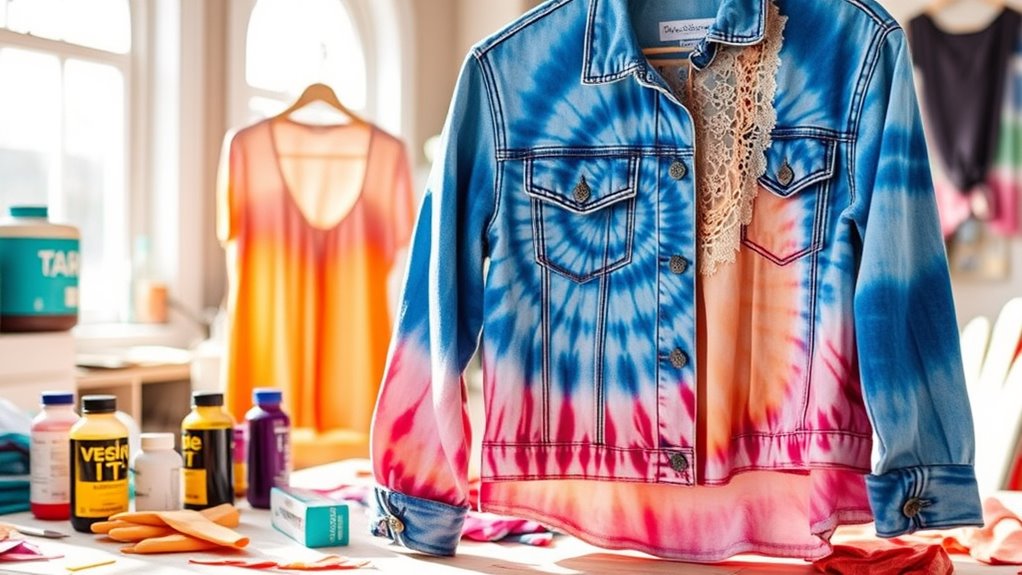
Experimenting with dyeing and color techniques opens up endless possibilities for creating unique boho garments. Natural dyes from turmeric, beetroot, and avocado pits deliver earthy, vibrant hues perfect for boho style projects. You can try tie-dye and batik methods to add intricate patterns that enhance the organic, free-spirited look of your upcycled pieces. These eco-friendly dyes are non-toxic, allowing you to customize shades and achieve one-of-a-kind results. Proper mordanting and fabric pre-treatment guarantee your colors stay vibrant and colorfast. Understanding dye fixation techniques ensures your colors remain vibrant and long-lasting. Additionally, exploring vertical storage solutions can help you organize your dyeing supplies efficiently, making your creative process smoother. Incorporating digital sound synthesis techniques can inspire new textures and effects in your dyeing process, encouraging innovation. Combining techniques like ombré or shibori can produce stunning layered gradient effects, elevating your textiles. For added precision, using pH testing strips can help you control dye bath acidity and achieve consistent results. Incorporating professional-grade dyes can also enhance color vibrancy and durability in your projects. With a little experimentation, you’ll craft truly individual boho garments that celebrate both creativity and sustainability.
Assembling Patchwork and Layered Textiles
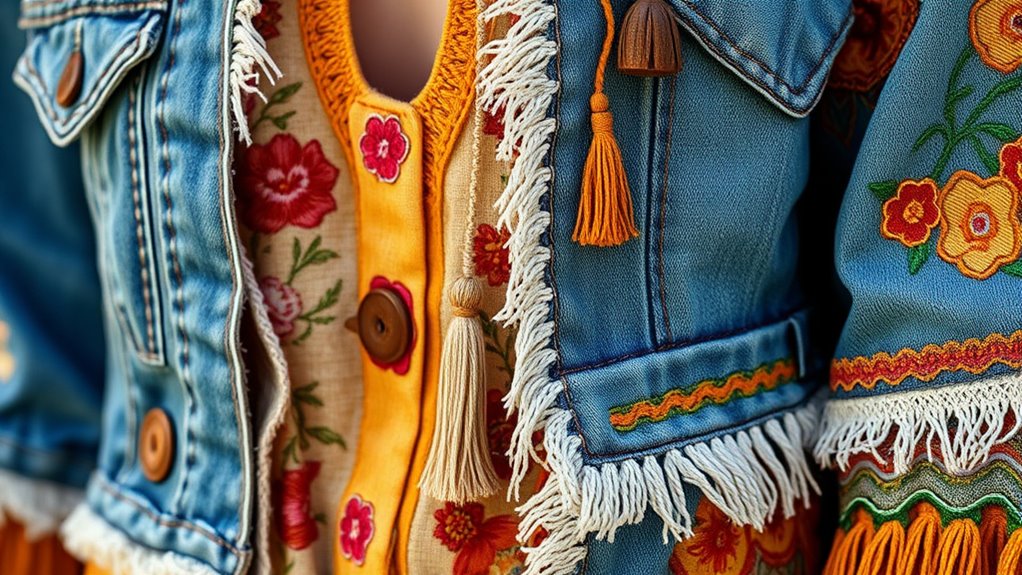
Creating patchwork and layered textiles allows you to craft truly unique boho garments by combining diverse fabrics and textures. With patchwork, you sew together fabric scraps featuring contrasting patterns and textures, resulting in a vibrant, bohemian-inspired look. Layered textiles in boho fashion are achieved by mixing fabrics of different weights and transparencies, adding depth and visual interest. To enhance the handmade, artisanal vibe, consider using raw edges or decorative topstitching on your patchwork pieces. Incorporate diverse textiles like vintage linens, sari fabrics, or reclaimed denim for a sustainable, colorful mix. Proper planning of fabric measurements and seam allowances guarantees your patchwork is seamless and cohesive. This approach allows you to create one-of-a-kind boho pieces that reflect your personal style and creativity.
Final Fitting and Adjustments for a Perfect Fit
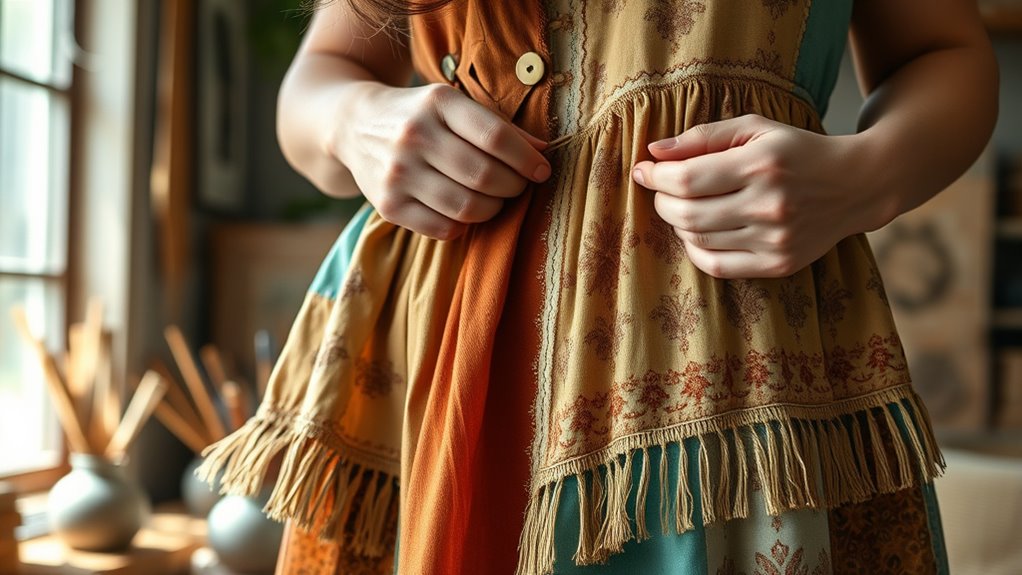
Before finalizing your boho garment, it’s essential to try it on and evaluate how it fits, drapes, and feels. As a boho woman, you want your DIY #Boho #Chic piece to embody relaxed chic fashion, so check the fit around the shoulders, side seams, and sleeves, especially if you’ve repurposed a graphic tee or Sleeve PonchoOne. Pin or mark areas that need taking in or letting out for a more tailored, bohemian style. Use a fitting muslin or scrap fabric to test adjustments before sewing directly on your garment. Make small, incremental changes—like sewing new darts or trimming excess fabric—to achieve that perfect fit and chic fashion vibe. Finish and press all seams for a polished, boho-chic look.
Styling Your Upcycled Pieces for a Boho Look
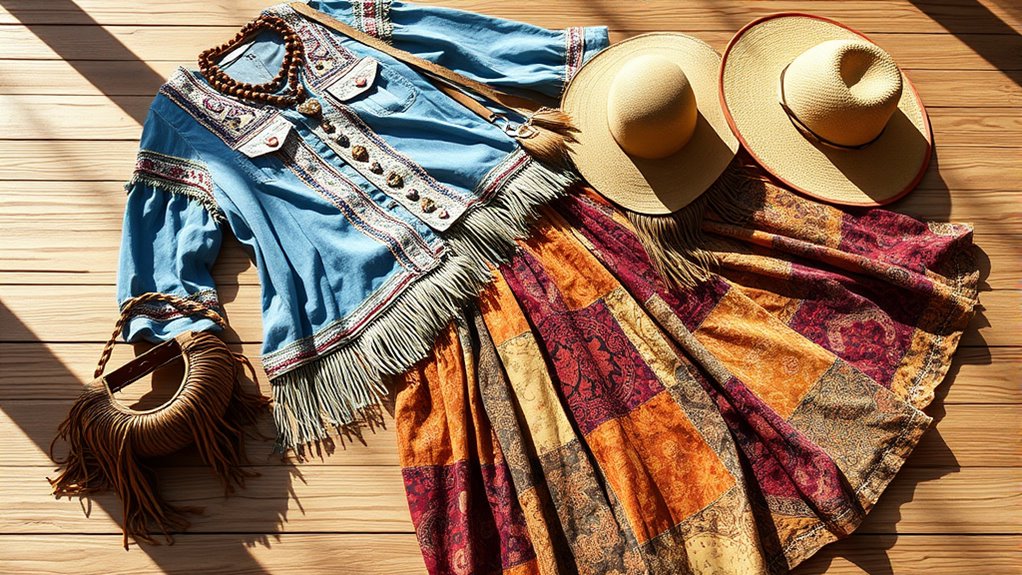
To achieve that effortless boho vibe, start by layering your upcycled pieces with accessories like long necklaces, beaded bracelets, and fringed bags. Mix textures and prints—think floral patterns with earthy tones or crochet details—to add personality. Balance oversized garments with fitted items like belts or layered jewelry to highlight your silhouette while keeping the relaxed aesthetic.
Layer With Accessories
Layering your upcycled boho pieces with accessories instantly elevates your look and adds rich texture. To achieve a truly boho vibe, incorporate statement jewelry like chunky beaded necklaces, layered bangles, or feather earrings. These pieces draw attention and enhance the free-spirited style. Adding wide-brimmed hats, headbands, or floral crowns creates a cohesive, relaxed feel that complements layered clothing. Textured accessories such as woven bags, fringe scarves, or embroidered belts further boost your boho flair. To create an eclectic look, mix and match different fabrics, patterns, and lengths in your accessories and clothing layers. This approach allows you to personalize your outfit, making it uniquely yours while maintaining that effortless boho charm.
Mix Textures and Prints
Mixing textures and prints is a powerful way to bring your upcycled boho outfits to life. Combine lace, denim, crochet, and silk to create rich visual interest and tactile contrast that embody the boho vibe. Layer florals, paisleys, and geometrics to build an eclectic, free-spirited look. Incorporate different fabric weights, like lightweight chiffons and heavier knits, to add depth and dimension. Pair patterned pieces with solid colors to maintain balance and prevent the outfit from feeling overwhelming. Using intentional contrasts in textures and prints highlights each upcycled piece, making your look uniquely personal and artisanal. Embrace the mix, and don’t be afraid to experiment—your creativity is the key to achieving authentic boho-chic style.
Frequently Asked Questions
What Is the Difference Between Boho and Boho Chic?
You’re wondering about the difference between boho and boho chic. Boho style is relaxed, eclectic, and earthy, inspired by bohemian fashion with layered textures and vintage elements. Boho chic, on the other hand, is a polished, modern take, combining relaxed boho aesthetics with sophisticated accessories, structured silhouettes, and luxe fabrics. It’s a more refined version, making it suitable for both casual and dressier occasions.
How Do You Make an Outfit Look Like Boho?
You want to master the boho look? Immerse yourself in flowing maxi skirts, kimono tops, and wide-leg pants that scream relaxed elegance. Layer on earthy tones, vibrant patterns, and textured fabrics like lace and fringe for maximum visual impact. Add layered jewelry, vintage finds, and effortless tousled hair to complete the vibe. Mix and match freely, embrace imperfections, and let your natural style shine—boho is all about expressing your free spirit!
Can You Upcycle Clothes Without a Sewing Machine?
Yes, you can definitely upcycle clothes without a sewing machine. You can use no-sew techniques like fabric glue, knots, or folding to transform old garments into boho-chic pieces. Adding iron-on patches or fabric tape makes repairs or embellishments easy. Natural fabric manipulation methods like braiding or knotting also work well. These methods are eco-friendly, simple, and perfect for beginners or quick projects, helping you craft unique, stylish pieces effortlessly.
What Is the Boho Dress Code?
Did you know that nearly 60% of people prefer boho fashion for its relaxed, artistic vibe? The boho dress code emphasizes flowy fabrics, earthy tones, and layered accessories, creating a free-spirited look. You’ll find maxi skirts, embroidered dresses, and vintage-inspired pieces made from natural materials like cotton and linen. This style is perfect for outdoor events and festivals, blending comfort with a laid-back, earthy aesthetic.
Conclusion
Now that you’ve learned these DIY boho upcycling tips, your wardrobe will never be the same—it’s like opening a treasure chest of endless creativity! With your talent for transforming old garments into stunning, one-of-a-kind pieces, you’ll turn heads and inspire others. Embrace your unique style and watch as your upcycled creations become the heart of your boho-chic look. Get ready to feel unstoppable—because no fashion adventure is more exciting than crafting your own absolute masterpiece!


